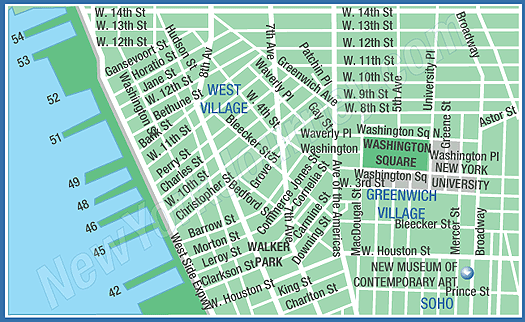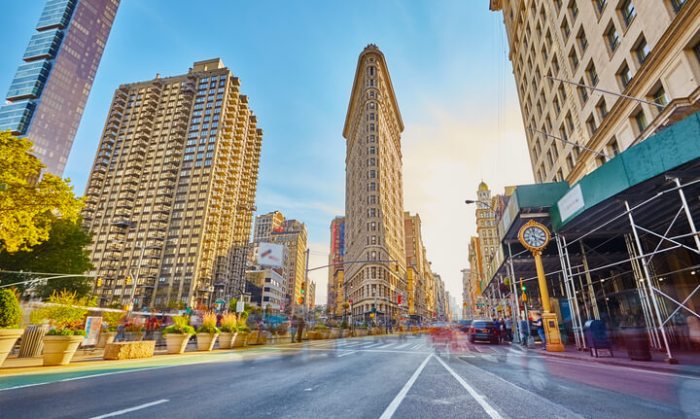BY KATHRYN ADISMAN | It’s not just the bike stations all in a row, metallic gleam — sterile as stainless steel — an ad for a bank.
Uh-oh! Here comes the grumble of the old West Villager.
There seems to be a concerted effort to put the West Village on the grid. As someone who’s spent her entire life off the grid, I take it personally. This used to be a walker’s paradise built for rambling.
But they haven’t killed the spirit. This little corner of the globe sturdily refuses to die. “Greenwich Village is a calling,” wrote Suze Rotolo in her memoir about the ’60s. Even when I arrived in the ’80s, I was drawn here by its bohemian history. Ironically, now my neighborhood is morphing into something else — namely, prime real estate.
My local bank branch financial adviser represents the new demographic. He owns a co-op in Queens and wants to buy my apartment as a pied-à-terre where he can crash after nights out entertaining clients. He’s an eager beaver. When I approached him a year ago, anticipating it would be a good time to sell, I had to pitch the virtues of a 250-square-foot back studio facing a brick wall. Now he’s chomping at the bit to replace me. I regale him with the history of the building — with my history.
I started as a subletter in 1984. Six months earlier I could have bought my unit for less than $20,000. Instead I end up paying quote “fair market value” rent to an overtenant for 20 years. I’m living the life of the starving artist in the garret. Meanwhile, the woman I sublease from is getting published, a successful chick-lit novelist. Before she finally decided to sell in 2004, I considered moving to the Upper West Side. The broker took one look at my application. “Oh, you live in the bordello district,” he remarked.
“What did he mean by that?” asks the banker, who has come to see my place today.
“Once upon a time, there was a prostitution ring upstairs on the fourth floor… .”
“Really?” He can’t help glancing upward.
“And then there was the young lawyer who had a different girl here every week, Asian mostly.”
“No kidding?”
“My next-door neighbor uses his place for trysts with his quote ‘girlfriend,’” I continue. “I’ve heard this used to be a sailors’ hotel.”
The young banker’s eyes widen. I did my own entertaining here. Oh, I could tell him a tale or two that would makes his eyes pop. Casually, I reach for the box of color snapshots on the desk.
“You’re never going to believe this… .” I hand him the box. There’s a photo of a woman wearing red: red lace top, red velvet skirt and red purple lipstick. She has black hair. She’s standing behind a bar in front of a mirror with a shelf full of liquor bottles, smiling as she pours.
“Do you know who that is?” Hint: It’s not Manet’s portrait of the barmaid reflected in the mirror.
“Is it…you?”
“Good guess. That’s me bartending more than 20 years ago.”
He leafs through the pics of me and another woman with our arms around each other.
“Who’s that?” he asks.
“I can’t remember her name, but that woman cost me my job,” I say. “She was a regular customer who worked at St. V’s. Used to come in at noon on her lunch hour to get her quota of Rolling Rocks, and she’s pissed the bar’s not open yet. So I turn to the owner, ‘It’s your fault we’re not open on time.’ ”
I’ll never forget the look on his face. As he kicked cartons around the back of the bar, I greeted every customer: “I think this is my last day.” I was fired, but…
“…The story isn’t over yet” is all I say the last time I go by the bank and my adviser escorts me out onto the street in his uniform suit and tie to catch a ray of sunlight. He thinks he’s calling the shots, this young hotshot, but he doesn’t know what shots I’ve poured.
At my place I’ve finally hooked up my turntable to the Bose so I can play my old LPs: The songwriter for Was (Not Was) — the ’80s soul-rock band out of Detroit my friend David formed with his buddy Don — “He was here,’’ says the ex-groupie in me.
In the file cabinet, a folder marked “Coney Island” contains a photo of the cast and crew of “Kid Twist,” the play by my N.Y.U. prof about the Coney Island gangster, produced on site, circa 1987 — “He was here, too” — not the head of Murder, Inc., but of Coney Island U.S.A. — “in two different decades!”
This place — I see myself referring with a grand gesture to my apartment the size of a closet — has seen a few things (and people) in its day. His eyes still wide from the “bordello” reference: “Yeah?”
“Yeah! Everything you’re thinking? It’s all true.”
“The Meatpacking District — it used to be transvestites,” the banker informs me, as if it were a fact out of Ripley’s.
“I know.” I don’t tell him about the night I was mistaken for one.
“When did it change?”
“It started in the ’90s under Giuliani.”
It was September 1999. I remember I went to vote after work and the polling place had been moved from the L.G.B.T. Center temporarily there. This little man in wire rims who could have been the banker taps me on the shoulder from behind.
“Got a light?” Ah, the good old days when we still smoked.
I produce my Bic and light his cigarette. Then, he asks me, “Where have all the he-she’s gone?”
“The what?”
“You know,” and he describes them.
“Oh! Did you think I was one?”
“I was hopin’!” Considering I’d once been mistaken for Howard Stern on the street, I wasn’t fazed.
I don’t mention to the financial adviser how Wire Rims and I pass an hour together at Hogs and Heifers commiserating — two outsiders sharing simpatico stories, singing “The Song of the Freak.” Neither of us fits in. This was the night I’d been passed over for a promotion at People. And he has a boring office job and his Italian Catholic wife never wants to…you know — do anything unconventional.
And I won’t tell the financial adviser how Wire Rims gets me to go with him down a darkened, wharf-bound street in pursuit of two he-she’s in heels strolling arm and arm, leading us on, when suddenly one of them turns around and confronts us: “What do you want?” she demands.
“She wants to watch me do you,” W.R. says, pointing in my direction.
“Who? Me?” I never said that. Do what?
The two of them burst out laughing in his face, our face, and turn tail. Their mocking laughter chases us down the street long after they are gone.
“Oh, well,” says my little friend, resigned to call it a night, as we shake hands to part. He promises to think of me later as he gets off. Thanks, I guess.
“Will you think of me?” he asks. Yes. …
…My prospective buyer shakes my hand at the door. Primed for the kill in his red sweat suit, he’s off to the nearest branch of New York Sports Club, before heading home on the subway to Queens. He’s a small-town kid in a corporate job. What does he want with my place?
The old aura of freedom in Greenwich Village still has the power to lure a new generation…off the grid.
Like any good museum curator who knows the value of his collection, I’m reluctant to sell. But thanks to the curiosity of my visitor, I see the “real” estate I now own is not bounded by four walls. It will accompany me wherever I go. Greenwich Village, says Rotolo, is “a state of mind.” Maybe it’s time to come out of the closet, literally. Even if it means venturing onto the grid to tell her story — the story of the woman who lived here, once upon a time.
Where’s the nearest bike station?





































